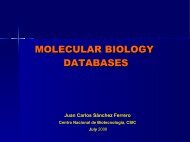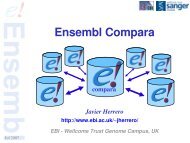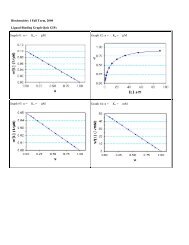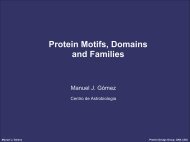Practical Course on Multiple Sequence Alignment - CNB - Protein ...
Practical Course on Multiple Sequence Alignment - CNB - Protein ...
Practical Course on Multiple Sequence Alignment - CNB - Protein ...
You also want an ePaper? Increase the reach of your titles
YUMPU automatically turns print PDFs into web optimized ePapers that Google loves.
Working with profiles<br />
When a number of member sequences of a protein family has been found, <strong>on</strong>e<br />
can search for additi<strong>on</strong>al family members in at least two different ways. The<br />
first is to search with each known member against a sequence database. The<br />
sec<strong>on</strong>d is to gather informati<strong>on</strong> from all known members, form a model for<br />
describing the properties of the members, and match this against a database<br />
of sequences. The latter has been shown to be superior in detecting weak<br />
relati<strong>on</strong>ships, i.e. remote family members. A number of different models has<br />
been applied. Each of these capture informati<strong>on</strong> about the family members<br />
and can be compared with sequences.<br />
Most comm<strong>on</strong> models for the representati<strong>on</strong> of domains and/or families are:<br />
• <strong>Sequence</strong> patterns (motifs): these include c<strong>on</strong>sensus sequences and<br />
regular expressi<strong>on</strong>s.<br />
• Positi<strong>on</strong>-specific scoring matrices (PSSM) or weight matrices. These<br />
are c<strong>on</strong>structed from MSAs and represent the variati<strong>on</strong> found in the<br />
alignment columns. It includes in additi<strong>on</strong> to positi<strong>on</strong>-specific scores<br />
gap penalties to be used when comparing the profile to a sequence.<br />
• Hidden Markov Models (HMM): these are c<strong>on</strong>served regi<strong>on</strong>s of multiple<br />
alignments represented as hidden markov models. The HMM is a<br />
statistical model that c<strong>on</strong>siders all possible combinati<strong>on</strong>s of matches,<br />
mismatches , and gaps to generate an alignment of a set of sequences.<br />
Probabilistic models describing protein domains and families (e.g. PSSMs,<br />
HMMs) are globally known as profiles (in c<strong>on</strong>trast to deterministic models<br />
such as sequence patterns).<br />
<strong>Sequence</strong> patterns<br />
When a collecti<strong>on</strong> of diverse proteins shares a comm<strong>on</strong> functi<strong>on</strong> or structure,<br />
sometimes all that is c<strong>on</strong>served between them is a few comm<strong>on</strong> residues that<br />
are critical for their structure and functi<strong>on</strong>. If the proteins are enzymes, these<br />
residues are typically those that are involved in the chemical catalysis in the<br />
active site.<br />
<strong>Sequence</strong> patterns are deterministic models: a sequence pattern is either<br />
matched or not matched by a sequence. The part of a sequence that actually<br />
matches a pattern is called an occurrence of the pattern. Patterns describing<br />
biologically meaningful similarities are called motifs.<br />
These motifs, typically around 10 to 20 amino acids in length, arise because<br />
specific residues and regi<strong>on</strong>s thought or proved to be important to the<br />
biological functi<strong>on</strong> of a group of proteins are c<strong>on</strong>served in both structure and<br />
sequence during evoluti<strong>on</strong>. These biologically significant regi<strong>on</strong>s or residues<br />
are generally:<br />
• Enzyme catalytic sites.<br />
23
















